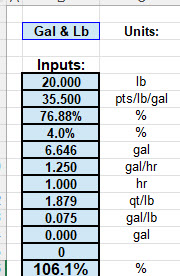What kind of difficulties did you have with the formulae? If the discussion is unclear, how can I improve it?...
I struggled with the formula discussed here to calculate conversion efficiency so I manually adjusted the 102% value to align with the Post-Boil / Pre-Boil Volume. Once entered I confirm the conversion efficiency by dividing the converted extract weight by the potential extract weight.
...
Brew on











































![Craft A Brew - Safale S-04 Dry Yeast - Fermentis - English Ale Dry Yeast - For English and American Ales and Hard Apple Ciders - Ingredients for Home Brewing - Beer Making Supplies - [1 Pack]](https://m.media-amazon.com/images/I/41fVGNh6JfL._SL500_.jpg)

















